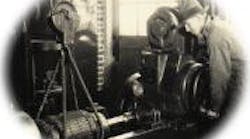One remanufacturing shop keeps a familiar machine-tool name going.
Starting a new machine-tool business can be a risky proposition. Many of today's best-known companies spent years building their names and reputations. However, for one Cleveland-based remanufacturing firm, the challenge was not creating a history, but rather living up to one.
Lucas Precision, the namesake of the Lucas Machine Tool Company, remanufactures existing Lucas horizontal boring, milling, and drilling machines. The company works from a stock of about 6,000 existing machines—a supply that started with Lucas Machine Tool's Model #1 boring mill, which ran to a production of 351 machines in 1901.
Henry M. Lucas made machine-tool history by designing and building the original of the now familiar 'Lucas-type' horizontal boring, milling, and drilling machine. This was the first commercially available machine designed with a fixed-height worktable and equipped for simultaneous adjustment of both the counterweighted machine head and the tailblock or backrest.
These innovaimproved both boring accuand workpiece setup. They also made it possible to construct machine beds with a heavily ribbed, deep-box design that offered substantially more rigidity than other boring machines of that era.
Production quantities for many of the early years averaged approximately 67 machines per year until 1930. Because of the Depression, entire production for 1931 was only 12 machines.
In the '40s, the U.S. Government took over the direct management of Lucas Machine to satisfy the production needs of World War II. Machine production increased in 1942 to at least twice that of the previous year with no additional employees. As a result, the company received the coveted Army/Navy "E" award for excellence in wartime production. Records show that a staggering 300 or so machines were shipped in 1943 alone.
The early 1950s saw the birth of the successful 41B and 42B models. The 41B, produced from 1950 had a total production of machines, while1,088 were made from 1950 1980. These two models were also the first in a long line of Lucas machines equipped with numerical control.
Production of the first 'tape controlled' Lucas machines began in 1956. And in fact, these machines were one of the early entrants into the field of numerically controlled machine tools.
In mid-1972, Lucas had significantly departed from previous designs when it began producing model 30T and 40T series machines. These the first Lucas models specifically built for operation variable-speed electronic drive systems for use modern CNC controls. Twelve years later, in 1984, manufacturing systems hot topic. Lucas's vision total factory automation system comprised of not only state-of-the-art CNC machines but also fully automated 'guided' vehicles transporting material and tooling to the machines; automatic part and tooling inspections tion; and automated part wash-down. All of which, Lucas envisioned, would be controlled by a central, master computer system coordinating part flow, tooling flow, and scheduling of all machining operations. Unfortunately, the system never made it beyond the prototype stage.
Lucas survived the late '80s, an extremely difficult period for the entire metalcutting machine industry, by operating across two broad fronts. Part of the factory did contract machining, while the remainder rebuilt and remanufactured any brand, type, or size of machine tool. But, the company still faltered and was officially closed on June 13, 1990.
During its 89 years of manufacturing, Lucas Machine produced over 5,700 horizontal boring, milling, and drilling machines— covering approximately 40 separate models—in addition to various presses, multispindle drills, conventional milling machines, and other miscellaneous machinery.
The assets of the Lucas Machine Division were sold by Litton Industries to a Cleveland-area group of private investors who started Lucas Precision as a limited partnership on June 14, 1990. Paul W. Mandelbaum is the current president and general manager of Lucas Precision, which is now part of the Lucas Precision Machine Tool Group that consists of Natco/Carlton, Lodge and Shipley, and Monarch Lathe.
Lucas supplies repair parts, field services, remanufactures, purchases existing machines for re-sale, and generally supports the large installed base of existing Lucas machines.
A growing reputation for spindlesAs a remanufacturer, Lucas Precision is quite proud of its capability for regrinding machine-tool spindles and sleeves. Although it wasn't expecting to provide the service, says company president Paul Mandelbaum, more and more customers have requested it. There is only a handful of shops that can do this type of spindle grinding, and Lucas has somewhat of a reputation for its expertise. So much so, he says, that the company even grinds different machine-tool company spindles for other remanufacturers from around the country. At the heart of this reputation, he explains, are employees trained by seasoned spindle-grinding veterans (40 plus years). In addition, he points to the grinding machine's foundation, which rests on a concrete pad with I-beams through the center. Springs support the beams and keep the 140,000-lb foundation free of vibration. "It's more than just the machine," says Mandelbaum, "it's also the feel of the operator that lets us grind spin-dles—up to 162-in. long—straight and true to within 0.0001 in." The company also specializes in rebuilding or repairing severely damaged spindle tapers. For these projects, skilled employees cut off the damaged end and insert a replaceable taper socket. These sockets apply to 5, 6, and 7-in. spindle diameters. According to Mandelbaum, his company can fit existing or even brand new spindles with replaceable noses. He recommends doing this because spindle tapers go soft after being ground once or twice. With a replaceable nose, users can remove the end and install a new one in a few hours. |












